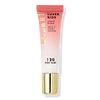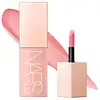What's inside
What's inside
 Key Ingredients
Key Ingredients

 Benefits
Benefits

 Concerns
Concerns

 Ingredients Side-by-side
Ingredients Side-by-side

Water
Skin ConditioningIsododecane
EmollientPEG-10 Dimethicone
Skin ConditioningButylene Glycol
HumectantDimethicone
EmollientTriethylhexanoin
MaskingDicaprylyl Carbonate
EmollientEthylhexyl Isononanoate
EmollientCetyl PEG/PPG-10/1 Dimethicone
EmulsifyingVinyl Dimethicone/Methicone Silsesquioxane Crosspolymer
Glycerin
HumectantSodium Chloride
MaskingMica
Cosmetic ColorantPhenoxyethanol
PreservativeDimethicone Crosspolymer
Emulsion StabilisingDisteardimonium Hectorite
StabilisingPolyglyceryl-2 Triisostearate
EmulsifyingSodium Dehydroacetate
PreservativeMethyl Methacrylate Crosspolymer
Ethylhexylglycerin
Skin ConditioningRosa Centifolia Flower Water
Skin ConditioningTriethoxycaprylylsilane
Citrus Medica Vulgaris Fruit Extract
AntioxidantIsopropyl Titanium Triisostearate
EmollientTriethoxysilylethyl Polydimethylsiloxyethyl Dimethicone
Skin ConditioningPunica Granatum Fruit Juice
MaskingCI 77891
Cosmetic ColorantCI 15850
Cosmetic ColorantIron Oxides
CI 19140
Cosmetic ColorantWater, Isododecane, PEG-10 Dimethicone, Butylene Glycol, Dimethicone, Triethylhexanoin, Dicaprylyl Carbonate, Ethylhexyl Isononanoate, Cetyl PEG/PPG-10/1 Dimethicone, Vinyl Dimethicone/Methicone Silsesquioxane Crosspolymer, Glycerin, Sodium Chloride, Mica, Phenoxyethanol, Dimethicone Crosspolymer, Disteardimonium Hectorite, Polyglyceryl-2 Triisostearate, Sodium Dehydroacetate, Methyl Methacrylate Crosspolymer, Ethylhexylglycerin, Rosa Centifolia Flower Water, Triethoxycaprylylsilane, Citrus Medica Vulgaris Fruit Extract, Isopropyl Titanium Triisostearate, Triethoxysilylethyl Polydimethylsiloxyethyl Dimethicone, Punica Granatum Fruit Juice, CI 77891, CI 15850, Iron Oxides, CI 19140
Water
Skin ConditioningDimethicone
EmollientPEG-10 Dimethicone
Skin ConditioningTriethylhexanoin
MaskingButylene Glycol
HumectantIsododecane
EmollientPhenyl Trimethicone
Skin ConditioningDisteardimonium Hectorite
StabilisingTrimethylsiloxysilicate
EmollientPEG-30 Dipolyhydroxystearate
EmulsifyingPropylene Carbonate
SolventLauryl PEG-9 Polydimethylsiloxyethyl Dimethicone
Skin ConditioningTocopherol
AntioxidantCaprylyl Glycol
EmollientTocopheryl Acetate
AntioxidantTriethoxycaprylylsilane
Polyhydroxystearic Acid
EmulsifyingTriethoxysilylethyl Polydimethylsiloxyethyl Dimethicone
Skin ConditioningIsopropyl Titanium Triisostearate
EmollientSilica
AbrasiveGalactoarabinan
Glycerin
HumectantGlyceryl Polyacrylate
Sodium Hyaluronate
HumectantCocoyl Hydrolyzed Collagen
CleansingMica
Cosmetic ColorantHydrogenated Lecithin
EmulsifyingPhenoxyethanol
PreservativeIron Oxides
CI 15850
Cosmetic ColorantCI 42090
Cosmetic ColorantCI 77891
Cosmetic ColorantWater, Dimethicone, PEG-10 Dimethicone, Triethylhexanoin, Butylene Glycol, Isododecane, Phenyl Trimethicone, Disteardimonium Hectorite, Trimethylsiloxysilicate, PEG-30 Dipolyhydroxystearate, Propylene Carbonate, Lauryl PEG-9 Polydimethylsiloxyethyl Dimethicone, Tocopherol, Caprylyl Glycol, Tocopheryl Acetate, Triethoxycaprylylsilane, Polyhydroxystearic Acid, Triethoxysilylethyl Polydimethylsiloxyethyl Dimethicone, Isopropyl Titanium Triisostearate, Silica, Galactoarabinan, Glycerin, Glyceryl Polyacrylate, Sodium Hyaluronate, Cocoyl Hydrolyzed Collagen, Mica, Hydrogenated Lecithin, Phenoxyethanol, Iron Oxides, CI 15850, CI 42090, CI 77891
Ingredients Explained
These ingredients are found in both products.
Ingredients higher up in an ingredient list are typically present in a larger amount.
Butylene Glycol (or BG) is used within cosmetic products for a few different reasons:
Overall, Butylene Glycol is a safe and well-rounded ingredient that works well with other ingredients.
Though this ingredient works well with most skin types, some people with sensitive skin may experience a reaction such as allergic rashes, closed comedones, or itchiness.
Learn more about Butylene GlycolCi 15850 is the pigment color red. It is an azo dye and created synthetically.
Azo dyes need to be thoroughly purified before use. This allows them to be more stable and longer-lasting.
This ingredient is common in foundations, lipsticks, and blushes. This color is described as brown/orangey red.
It has many secondary names such as Red 6 and Red 7. According to a manufacturer, Red 6 usually contains aluminum.
Learn more about CI 15850Ci 77891 is a white pigment from Titanium dioxide. It is naturally found in minerals such as rutile and ilmenite.
It's main function is to add a white color to cosmetics. It can also be mixed with other colors to create different shades.
Ci 77891 is commonly found in sunscreens due to its ability to block UV rays.
Learn more about CI 77891Dimethicone is a type of synthetic silicone created from natural materials such as quartz.
What it does:
Dimethicone comes in different viscosities:
Depending on the viscosity, dimethicone has different properties.
Ingredients lists don't always show which type is used, so we recommend reaching out to the brand if you have questions about the viscosity.
This ingredient is unlikely to cause irritation because it does not get absorbed into skin. However, people with silicone allergies should be careful about using this ingredient.
Note: Dimethicone may contribute to pilling. This is because it is not oil or water soluble, so pilling may occur when layered with products. When mixed with heavy oils in a formula, the outcome is also quite greasy.
Learn more about DimethiconeDisteardimonium Hectorite comes from the clay mineral named hectorite. It is used to add thickness to a product.
It can also help stabilize a product by helping to disperse other ingredients.
Hectorite is a rare, white clay mineral.
Learn more about Disteardimonium HectoriteGlycerin is already naturally found in your skin. It helps moisturize and protect your skin.
A study from 2016 found glycerin to be more effective as a humectant than AHAs and hyaluronic acid.
As a humectant, it helps the skin stay hydrated by pulling moisture to your skin. The low molecular weight of glycerin allows it to pull moisture into the deeper layers of your skin.
Hydrated skin improves your skin barrier; Your skin barrier helps protect against irritants and bacteria.
Glycerin has also been found to have antimicrobial and antiviral properties. Due to these properties, glycerin is often used in wound and burn treatments.
In cosmetics, glycerin is usually derived from plants such as soybean or palm. However, it can also be sourced from animals, such as tallow or animal fat.
This ingredient is organic, colorless, odorless, and non-toxic.
Glycerin is the name for this ingredient in American English. British English uses Glycerol/Glycerine.
Learn more about GlycerinIsododecane is a fragrance, emollient, and solvent.
As an emollient, it helps your skin stay soft and hydrated. Emollients help trap moisture into your skin.
Isododecane's role as a solvent makes it a great texture enhancer. It spreads smoothly on skin and does not leave a sticky feeling behind. Isododecane also helps prevent color transfer in makeup products.
Isododecane is not absorbed into skin.
Learn more about IsododecaneIsopropyl Titanium Triisostearate isn't fungal acne safe.
Mica is a naturally occurring mineral used to add shimmer and color in cosmetics. It can also help improve the texture of a product or give it an opaque, white/silver color.
Serecite is the name for very fine but ragged grains of mica.
This ingredient is often coated with metal oxides like titanium dioxide. Trace amounts of heavy metals may be found in mica, but these metals are not harmful in our personal products.
Mica has been used since prehistoric times throughout the world. Ancient Egyptian, Indian, Greek, Roman, Aztec, and Chinese civilizations have used mica.
Learn more about MicaPeg-10 Dimethicone is silicone with conditioner and emulsifier properties. It mostly acts as an emollient in skincare and and humectant in haircare.
According to the manufacturer, acidic formulations decrease the stability of this ingredient. It works best in neutral or near neutral formulations.
Phenoxyethanol is a preservative that has germicide, antimicrobial, and aromatic properties. Studies show that phenoxyethanol can prevent microbial growth. By itself, it has a scent that is similar to that of a rose.
It's often used in formulations along with Caprylyl Glycol to preserve the shelf life of products.
Triethoxycaprylylsilane is a silicone used to bind and stabilize ingredients.
As an emulsifier, it helps prevent ingredients from separating. This can help elongate the shelf life of products.
Triethoxycaprylylsilane is often used to coat mineral sunscreens ingredients to help give a better feel. It also helps reduce oxidative stress in sunscreens.
Learn more about TriethoxycaprylylsilaneTriethoxysilylethyl Polydimethylsiloxyethyl Dimethicone is a type of silicone.
Triethylhexanoin is created from glycerin and 2-ethylhexanoic acid. It is a solvent and emollient.
As a solvent, Triethylhexanoin helps dissolve ingredients to stable bases or help evenly distribute ingredients throughout the product.
It is also an emollient and helps condition the skin.
Learn more about TriethylhexanoinWater. It's the most common cosmetic ingredient of all. You'll usually see it at the top of ingredient lists, meaning that it makes up the largest part of the product.
So why is it so popular? Water most often acts as a solvent - this means that it helps dissolve other ingredients into the formulation.
You'll also recognize water as that liquid we all need to stay alive. If you see this, drink a glass of water. Stay hydrated!
Learn more about WaterThis ingredient is a combination of red, black, and yellow iron oxide pigments. This combination of colors is usually found in foundation, because it results in a "skin" color.